Recently declared a biodiversity heritage site by the Tamil Nadu government, the place also has sculptures of a Jain Tirthankara and a Saiva saint from Gujarat.
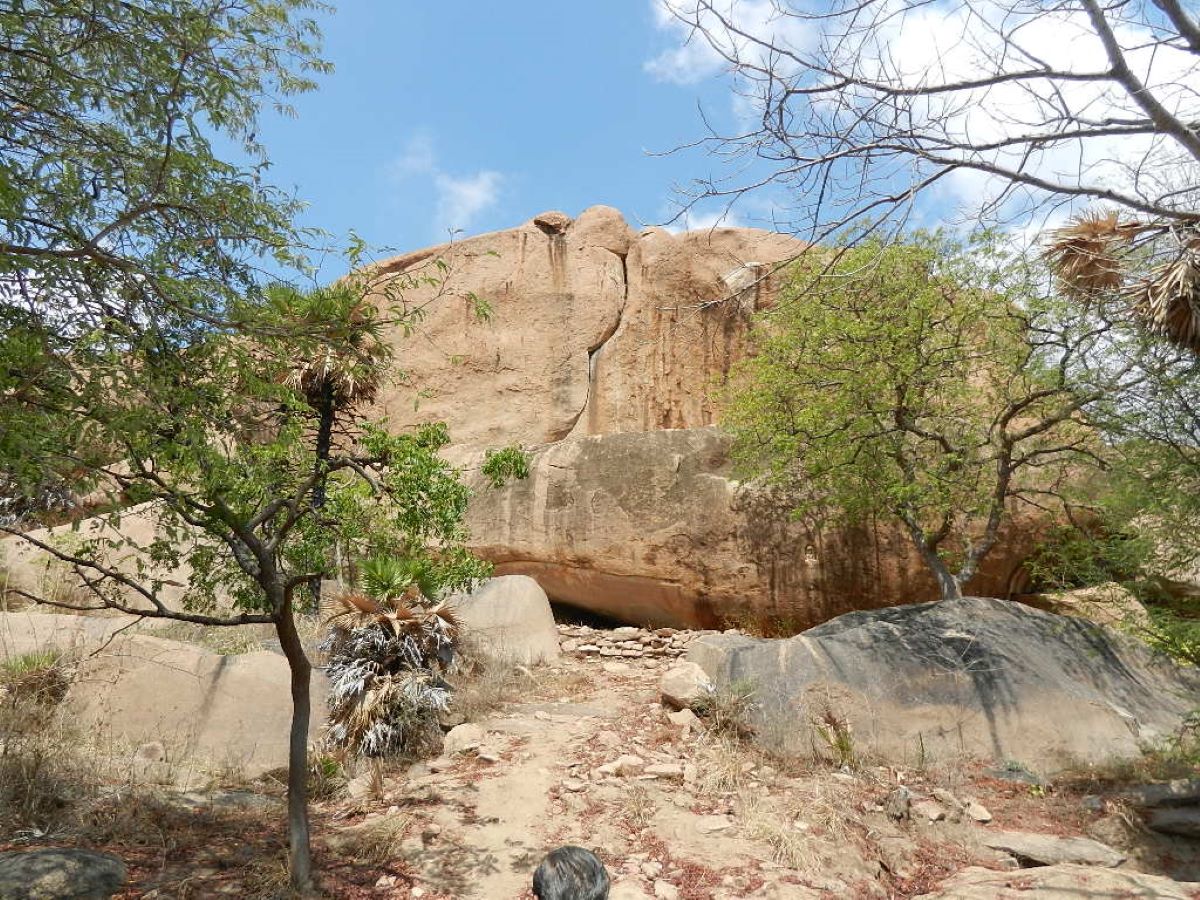
Arittapatti hill with the Jain cave (R Gopu)
Arittapatti is a village near Madurai that has recently been in the news as it was declared a biodiversity heritage site by the Tamil Nadu government.
The neighbouring rocky hills are home to ancient and medieval monuments of great historical interest and value.
In a natural cavern in the village, there are stone beds, smoothened by sculptors sponsored by Jain devotees. These are intended to reduce the great discomfort of Jain or Shramana ascetics — of sleeping on rough rock to the marginally less discomfort of smooth rock.
A Tamil inscription in the Tamil Brahmi script of the 2nd century BCE reads “Nelveli Ciziyan Atinan Veliyan muzhaakai kotupiton”, which means “Chizhiyan Atinan Veliyan of Nelveli caused to be given (sponsored)” — that is, he sponsored the smoothening of the stone beds in the cave for the monks.
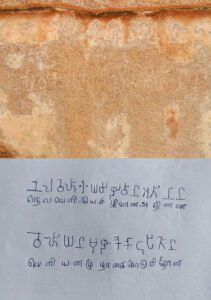
(Above) The ‘Nelveli Ciziyan Atinan Veliyan …’ Tamil Brahmi inscription in Arittapatti, a village near Madurai; (Below) The same inscription in the Tamil Brahmi script with the modern Tamil equivalents below (R Gopu)
On the face of the rock is a sculpture of a Jain Tirthankara, clearly identifiable by the triple umbrella above him. Some traces of paints of many colours, mainly red and green (showing flowers and leaves) can be seen around the image of the Tirthankara.
While the Pallava paintings in the Kanchipuram Kailasanatha temple, Chola paintings in the Thanjavur temple, and Pandya paintings in Sithannavasal cave are famous, these painted Tirthankara images are evidence that even sculptures in remote places were once plastered and painted.
Below this Tirthankara image is a Tamil inscription in Vattezhuthu script.
While the Tamil Brahmi script was prevalent from around the second century BCE to the fourth century CE, lasting a little past the Sangam era, it morphed into the Vattezhuthu script in the fourth–fifth centuries. Vattezhuthu was in vogue until the tenth century CE.
The Vattezhuthu inscription in the village mentions Ajjanandi, a legendary Jain acharya. He is also mentioned in several other Jain monument inscriptions of the region.
One of these is in nearby Anaimalai, more famous for the rock-cut cave temple for Lord Narasimha, the fourth avatar of Vishnu.
Also nearby is Mangulam, where a Brahmi inscription, the oldest in the Tamil region, was discovered by Robert Sewell in 1882 and rediscovered by KV Subramaniya Iyer in 1906.
Brahmi inscriptions such as those of Mauryan Emperor Ashoka are found all over India. A British scholar James Prinsep discovered that these were mostly in various Prakrit languages, by deciphering short donor inscriptions on the Sanchi stupa.
Sanskrit inscriptions in Brahmi are also present all over India. At first, Brahmi inscriptions such as those in Mangulam were also considered to be Prakrit, even by epigraphists such as V Venkayya, because they were in Brahmi
But in 1919, Krishna Sastri discovered special letters absent in Prakrit / Sanskrit, which he identified as the exclusively Tamil letters la, zha, ra, and na.
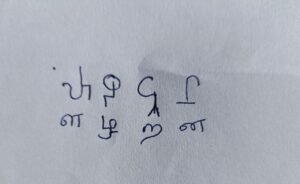
Special letters in Tamil Brahmi or Tamizhi (found in the Arittapatti inscription and elsewhere) that are absent in Brahmi. The modern Tamil script equivalents are below (R Gopu)
In 1924, KV Subramaniya Iyer observed that most of the varga letters in Prakrit/Sanskrit are absent in Brahmi inscriptions of Tamil Nadu. He deduced that this script was Tamil Brahmi, a special adaptation of Brahmi for the Tamil language.
The Mangulam inscription carries the name of the Pandya king Nedunchezhiyan.
Chizhiyan Atinan of the Arittapatti Tamil Brahmi inscription, in contrast, may not have been a royal but a prosperous citizen.
It is remarkable that a king, saint, and commoner alike feature in the inscriptional history of the region.
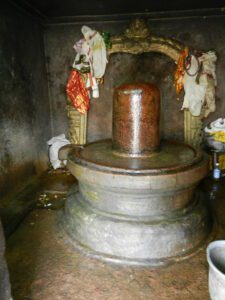
Lingam in the sanctum of Pandya cave temple for Sivan in Arittapatti has been scooped out of the mother rock (R Gopu)
Also in the village is a Pandya cave temple popularly called Idaicchi mandapam (goat herder’s hall) by local people.
Unfortunately, the Arittapatti cave temple for Sivan has no inscription but scholars consider it to be of the 7th–8th century CE. The lingam in the sanctum is scooped out of the mother rock, a distinctly Pandya feature.
The outer façade of the cave temple has two images: One of them is Ganesha, typical in Pandya cave temples.
The other is a very rare sculpture of Lakulisha, one of the great acharyas of Saivism. The image is slightly damaged — his nose is broken. He is seated and carries a mace in one hand.
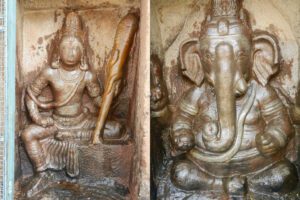
Sculptures of Lakulisha (Left) and Ganesha (Right) on the outer façade of the Arittapatti Sivan cave temple (R Gopu)
Most other Pandya cave temples feature Jyeshtaa Devi.
Lakulisha, a saint born in Gujarat, was the founder of the Paashupata school of Saiva philosophy. His sculptures are often featured as a koshta deva in Siva temples of the Chalukyas in north Karnataka, but are rare in Tamil Nadu.
Both the Jain site and the cave temple for Siva in the village are one of several found in a ring around the city of Madurai.
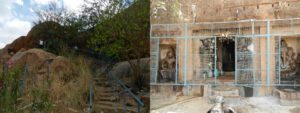
(Left) Arittapatti hill and the path to the Sivan cave temple; (Right) The Pandya cave temple in the village near Madurai (R Gopu)
Around Madurai, some of the other cave temples are:
1 and 2) Laadan Koil in Anaimalai, a temple for Murugan right next to the Narasimha cave temple mentioned earlier;
3) Tenparan Kunram, a cave temple with images of Nataraja and some Nayanmars (Saivite saints from Tamil Nadu);
4 and 5) Kunrathur, with two small cave temples for Sivan called Udayagiri and Astagiri;
and 6) Samanar Malai with a natural cave that has some Jain sculptures.
For more on the above sites and other cave temples of the Pandyas, you can listen to a talk by the author (in Tamil):
The Arittapatti Jain and Saiva monuments have been preserved in mostly original condition because they are somewhat remote, and have not been modernised or suffered much vandalism.
Conservationists and history enthusiasts have fought several battles to save such monuments from granite mining, neglect, and other such threats. Hopefully, the government’s proclamation of the village near Madurai as a heritage site will protect and conserve them for future generations.
(R Gopu is part of the Tamil Heritage Trust (THT), and is interested in history and heritage. He is also one of the co-founders of the Varahamihira Science Forum. The author thanks Dr Santhalingam, retired archaeologist, for a guided tour of these sites, and Prof Swaminathan, founder of THT for introducing him to epigraphy)

Feb 28, 2024

Feb 22, 2024

Feb 18, 2024

Feb 12, 2024

Feb 11, 2024